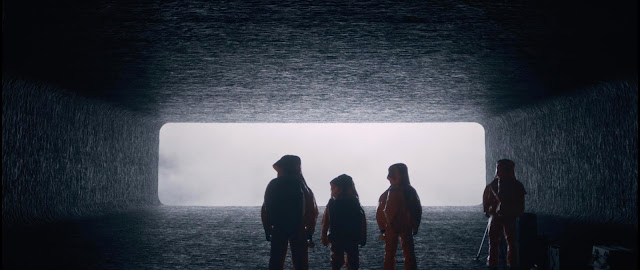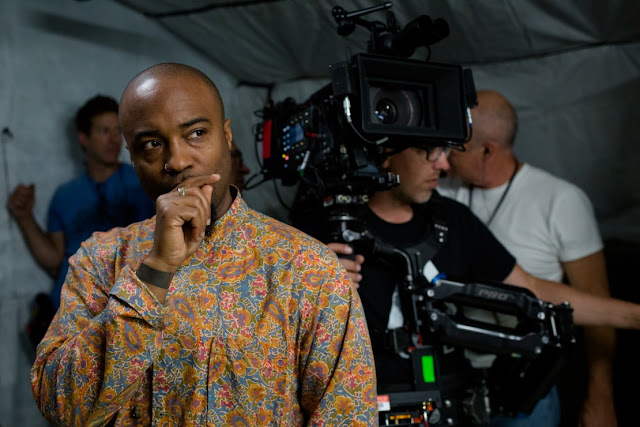 |
| Arrival (2016) - By Denis Villeneuve |
Denis Villeneuve's Arrival hits Indian cinemas on the 25th. Made in the same line as Close Encounters of the Third Kind (1977), Contact (1997) or Kubrick's immortal saga, 2001: A Space Odyssey (1968), the new film focuses more on a primordial question - that of language.
Before I proceed further, I must recommend this film to anyone who loves thinking while watching a film. Anyone who is a participant observer of movies, to whom movies are not just moving shadows and reflections on the screen to be enjoyed over big bowls of caramelized popcorn and coke, this film would create some resonance.
Our readers have told us that more often we leave our reviews open-ended. We do not recommend or reject a film definitely. This is to them.
Go and watch Arrival if you want to bask in the glory of what makes us human - where rationality is same as emotions at the highest level.
They arrive one by one
But, the film has problems!
My life began with a platter of science fiction novels. It is not easy to be the son of a serious Sci Fi writer and not to be absorbed in the world of speculative science and philosophy. In my father's novel Ki Sei Barta (The Message, 1987), a comet hits earth at a significant crossing point of certain latitude and longitude. Scientists find the comet to be the source of an intelligent communication - a spaceship either fitted with a supercomputer or an intelligent mind (the difference between these two was not yet under fierce debate, as they would be, even in popular literature, between Marvin Minsky and Roger Penrose.) Named Neil's comet, the object sends radio signal in predictable ways - first the series of primes, then the fibonacci on a secondary signal, then the model of hydrogen atom and subsequent atoms by fusion in later stages on subsequent signals.
The AI expert, Prof Sayantani Ray, asks the source of intelligence two specific questions (it was not clear how such questions could be asked in a universal language format. My father was not an expert either in machine language algorithm or linguistics) - What is love? What is Mind?
My life began with a platter of science fiction novels. It is not easy to be the son of a serious Sci Fi writer and not to be absorbed in the world of speculative science and philosophy. In my father's novel Ki Sei Barta (The Message, 1987), a comet hits earth at a significant crossing point of certain latitude and longitude. Scientists find the comet to be the source of an intelligent communication - a spaceship either fitted with a supercomputer or an intelligent mind (the difference between these two was not yet under fierce debate, as they would be, even in popular literature, between Marvin Minsky and Roger Penrose.) Named Neil's comet, the object sends radio signal in predictable ways - first the series of primes, then the fibonacci on a secondary signal, then the model of hydrogen atom and subsequent atoms by fusion in later stages on subsequent signals.
The AI expert, Prof Sayantani Ray, asks the source of intelligence two specific questions (it was not clear how such questions could be asked in a universal language format. My father was not an expert either in machine language algorithm or linguistics) - What is love? What is Mind?
In reply, Neil's comet explodes. The idea of interrupt comes from the nervous system, as well as all the other systems of the human body. Interrupt is an essential part of any communication system. Through interrupts, any system prioritizes one action over others and channelizes resources to that action for a limited time. This is a cornerstone in multitasking. However, if an input is given without an adequate interrupt, along with several other inputs, all vying for priority with one another, the system comes to a halt. The machine hangs.
 |
| Space: Billions over billions of stars : PC - NASA |
A similar result would take place when a library function, which does not exist, is called; or when a question is asked the answer to which cannot be obtained through logic gates.
This was a classical problem of functional logic. The system going in limbo has been addressed in various Science Fiction novels, including, if I correctly remember, some stories of Trurl and Klapacius by Stanislaw Lem. In my father's book, the system explodes. That, in the logic of that novel and its writer, shows, beyond doubt, that Neil's comet was a computer, and not a thinking mind.
However, this novel introduced the problem of language to me, a teenager, in pre-globalization India.
Since time immemorial, our kind has imagined aliens coming to our territories with some message. Sometimes, we sent a messenger to get Messages from them. Moses was such a messenger.
In Vedic Sub-Himalayan regions, rishis would get such messages in flashes. Buddha, and his followers, tried to give some logical structure to reading nature. But, they did not erase the possibility of intuition. The contemporary Buddhist practice of Vipassana attempts at knowing the totality of cosmos at one go, through a kind of logical structure.
All cultures always believed in a Message.
When the Pioneer 10 and 11 were released to the space, in 1972-73, Astronomer Carl Sagan and his wife Linda designed two plaques with graphic messages from human kind. The space shuttles carried those messages addressed to unknown ETs. After 34 years, who knows where they are in the deep black of the outer space, beyond the solar system.
 |
| One of their symbols: Attempt at decoding the message |
In Arrival, multiple monolithic structures arrive from outer space to particular points on earth near big cities. The US defence force takes a recording of the aliens' voices to the linguist Dr Louise Banks (played by Amy Adams) for interpretation. Louise urged for meeting the aliens in person, instead.
A dozen semi-lunar spaceships from another civilization hover over the sky. It is an unprecedented invasion. Nobody knows what the aliens want. Nobody knows why they are here.
In films, one after another, with the exception of only a handful (such as ET or Contact), any guest from another planet is shown in an adverse color. The paradigm is, for sure, the Spaniard's invasion of the native America, or the British invasion of Australia. Such paradigms are voiced in many films, including Contact and Arrival too.
But, that is the human paradigm. That need not be universal. Our films always follow the anthropomorphic principle. That is these films' failure.
A dozen semi-lunar spaceships from another civilization hover over the sky. It is an unprecedented invasion. Nobody knows what the aliens want. Nobody knows why they are here.
In films, one after another, with the exception of only a handful (such as ET or Contact), any guest from another planet is shown in an adverse color. The paradigm is, for sure, the Spaniard's invasion of the native America, or the British invasion of Australia. Such paradigms are voiced in many films, including Contact and Arrival too.
But, that is the human paradigm. That need not be universal. Our films always follow the anthropomorphic principle. That is these films' failure.
 |
| The message: Interpretation goes on |
However, there is something unique about Arrival.
While the message from the outer space, or from another level of existence, is a popular motif in religions and mythologies, not many films portray a linguist as the key person in an interaction between man and other intelligent lives.
Contact (1997) showed a SETI (Search for Extra Terrestrial Intelligence - Sagan's pet project) scientist, Dr Eleanor Ellie Arroway (played by Jodie Foster). The hero of Arrival, Louise, strikingly similar to Ellie in her approach to life as well as a little brittle look, is not a scientist of a similar kind.
Finally the conversation is entrusted to a specialist of the sign system - a linguist.
The decoding of an unknown language from a culture with an unknown paradigm is not possible unless either the paradigm or the code is known. A Rosetta stone is needed. This is why many cuneiform scripts from the prehistoric Sumeria or the writing from the Harappan civilizations were not deciphered. There was no Rosetta stone - nothing that could act as a bilingual reference.
Exactly here the film fails.
The paradigm of communication need not be anthropomorphic. Our logic of communication need not be universal. While the written language is more universal than the spoken (which is why China could have a single written language), the syntax, the logic behind syntax as well as the universal grammar need not be universal at all.
We do not really know how a complex technology like language evolved. It is surprising to note that, universally, the human languages did not really grow in complexity with time. Classical Sanskrit is much more complex than modern English. At the same time, Vedic Sanskrit had a much freer syntax compared to most modern Indian languages.
Villenueve and the screenplay writer Eric Heisserer picks the Chomskyan idea of the change in nerve synapses in the brain when we learn something. Learning a new paradigm may open endless possibilities to perceive Time. While Time as a static dimension is an idea as old as the young Einstein, changing brain pathways to traverse in time like any other dimension of space is certainly new to cinema. Even Solaris (1972) did not attempt this.
Villeneuve made Incendies (2010) - that works like a splinter. Last year, I reviewed his film Sicario . That attempted a totally different ballgame.
While the message from the outer space, or from another level of existence, is a popular motif in religions and mythologies, not many films portray a linguist as the key person in an interaction between man and other intelligent lives.
Contact (1997) showed a SETI (Search for Extra Terrestrial Intelligence - Sagan's pet project) scientist, Dr Eleanor Ellie Arroway (played by Jodie Foster). The hero of Arrival, Louise, strikingly similar to Ellie in her approach to life as well as a little brittle look, is not a scientist of a similar kind.
Finally the conversation is entrusted to a specialist of the sign system - a linguist.
The decoding of an unknown language from a culture with an unknown paradigm is not possible unless either the paradigm or the code is known. A Rosetta stone is needed. This is why many cuneiform scripts from the prehistoric Sumeria or the writing from the Harappan civilizations were not deciphered. There was no Rosetta stone - nothing that could act as a bilingual reference.
Exactly here the film fails.
 |
| Director Denis Villenueve and Jeremy Renner on the set |
We do not really know how a complex technology like language evolved. It is surprising to note that, universally, the human languages did not really grow in complexity with time. Classical Sanskrit is much more complex than modern English. At the same time, Vedic Sanskrit had a much freer syntax compared to most modern Indian languages.
Villenueve and the screenplay writer Eric Heisserer picks the Chomskyan idea of the change in nerve synapses in the brain when we learn something. Learning a new paradigm may open endless possibilities to perceive Time. While Time as a static dimension is an idea as old as the young Einstein, changing brain pathways to traverse in time like any other dimension of space is certainly new to cinema. Even Solaris (1972) did not attempt this.
Villeneuve made Incendies (2010) - that works like a splinter. Last year, I reviewed his film Sicario . That attempted a totally different ballgame.
 |
| They wait for the aliens to appear on the other side |
In Arrival, he stretched the horizon further.
In the beginning of Kubrick's 2001: A Space Odyssey, a mysterious monolithic, super-computer alike, structure arrives among the pre-human beasts, from nowhere. Mystery leads to fear. Fear leads to strong reactions.
In the beginning of Kubrick's 2001: A Space Odyssey, a mysterious monolithic, super-computer alike, structure arrives among the pre-human beasts, from nowhere. Mystery leads to fear. Fear leads to strong reactions.
These reactions lead to some change in the species. That change leads to the use of hands. That, in turn, leads to the use of tools. The first tools were, invariably, weapons of destruction.
That is how the first few minutes of Kubrick's epic saga pricks us to believe. This is where Arrival strikes.
That is how the first few minutes of Kubrick's epic saga pricks us to believe. This is where Arrival strikes.
To know how, you should catch the film in a theatre!
This is not a small-screen film.
The cinematography by Bradford Young is a relishing factor that multiplies the film's appeal.
Bradford is a friend of A Potpourri. We shall have a solo feature on this leading Cinematographer from our times, in near future.
In this film, he played with two different, broad moods, the standing time - the unending cycle of time in the golden glow, in amber color; in stark contrast with the momentary present time in cool blue.
In this film, he played with two different, broad moods, the standing time - the unending cycle of time in the golden glow, in amber color; in stark contrast with the momentary present time in cool blue.
 |
| Bradford Young: the Director of Photography on the set PC : Jan Thijs © 2016 PARAMOUNT PICTURES. ALL RIGHTS RESERVED. |
Bradford may be called the new Prince of Darkness (the old one was Gordon Willis - the man who lit up The Godfather (1972). In the more introspective shots, in reality space-time, Louise is exposed 3 under. If you understand anything in photography, you may understand the risk. Bradford was exposing for the highlight, for the sky at LV 14, if not 15.
That gave the film its unique look. It is to see how much of the suppressed mood comes out in the blu ray version. Exactly for this reason, the film must be seen in the best DCP projection in theater.
Bradford Young is definitely going to be nominated for an Academy Award in Cinematography, in 2017, for Arrival.
Arrival is about the universality of communication.
Watch it on the biggest screen possible.
Rating: 8/10
That gave the film its unique look. It is to see how much of the suppressed mood comes out in the blu ray version. Exactly for this reason, the film must be seen in the best DCP projection in theater.
Bradford Young is definitely going to be nominated for an Academy Award in Cinematography, in 2017, for Arrival.
Arrival is about the universality of communication.
Watch it on the biggest screen possible.
Rating: 8/10
Readers, please feel free to share your views/opinions in the comment box below. As always your feedback is highly appreciated!
Wikipedia
Trailer: Arrival (2016)
People who liked this also liked...



0 comments:
Post a Comment
Thanks for sharing for valuable opinion. We would be delighted to have you back.